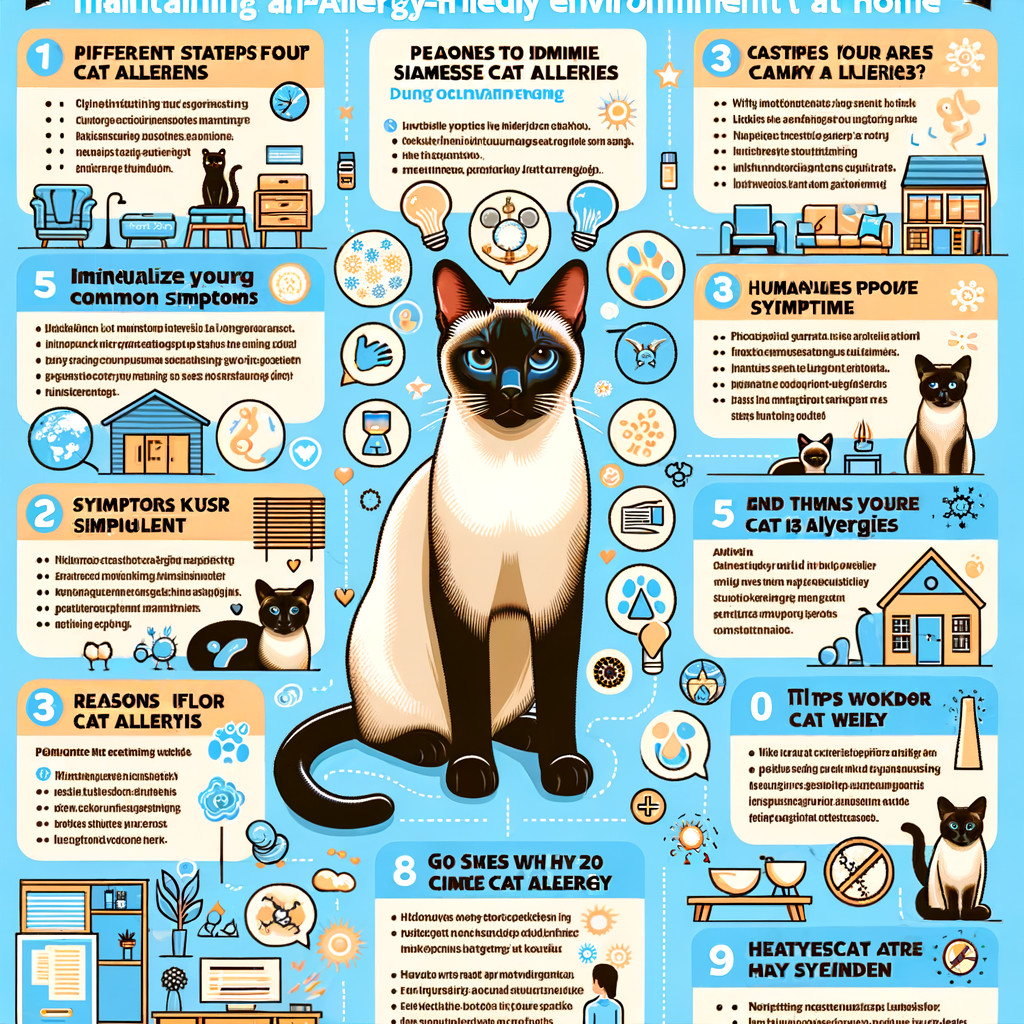
Introduction to Siamese Cat Allergies
When it comes to our feline friends, allergies can be a significant concern. This is especially true for Siamese cats, a breed known for its striking blue eyes and short, glossy coat. In this blog post, we will explore the nature of allergies and delve into the specifics of Siamese cat allergies.
- Understanding the nature of allergies
Allergies occur when the body’s immune system reacts to a foreign substance, such as pollen, bee venom, or pet dander. This reaction often causes sneezing, itching, and various other symptoms. In humans, allergies to cats are quite common and are typically triggered by exposure to a protein found in cat saliva, urine, and dander (dead skin cells).
It’s important to note that not everyone who has allergies will react to cats, and not all cats will trigger allergies in those who are susceptible. The severity of allergies can vary greatly from person to person, and even from cat to cat.
- Specifics of Siamese Cat Allergies
Siamese cats, like all cats, produce the protein Fel d 1 that is responsible for triggering allergic reactions in humans. However, Siamese cats have been reported to produce less of this protein compared to many other breeds, making them a better choice for those with mild to moderate allergies.
Despite this, it’s crucial to remember that no cat breed is completely hypoallergenic. Even Siamese cats can cause allergic reactions in some people. Factors such as the individual’s sensitivity, the cat’s grooming habits, and even the cat’s diet can influence the amount of allergens a Siamese cat produces.
Understanding the nature of allergies and the specifics of Siamese cat allergies can help potential cat owners make informed decisions. It’s always recommended to spend time with a Siamese cat before bringing one into your home, to see if any allergic reactions occur.
Allergy-Friendly Home for Cats: Basics
Living with cats can be a joy, but for those with allergies, it can also be a challenge. However, by creating an allergy-friendly environment and reducing allergens at home, you can enjoy the companionship of your feline friends without the discomfort of allergies.
- Importance of Creating an Allergy-Friendly Environment
- General Tips for Reducing Allergens at Home
- Regular Cleaning: Dust and vacuum your home regularly to remove allergens. Pay special attention to areas where your cat spends most of its time.
- Use Allergen-Reducing Products: Use air purifiers, allergen-reducing sprays, and hypoallergenic cleaning products.
- Groom Your Cat Regularly: Regular grooming can help reduce the amount of dander (a common allergen) that cats shed.
- Limit Cat Access: Keep certain areas of your home, like your bedroom, off-limits to your cat to create a “safe zone” where allergens are less likely to accumulate.
Creating an allergy-friendly environment is crucial for both humans and cats. For humans, it reduces the risk of allergic reactions, which can range from mild discomfort to severe health issues. For cats, an allergy-friendly environment means less exposure to substances that can irritate their skin, eyes, and respiratory system.
There are several ways to reduce allergens at home. Here are some general tips:
Remember, creating an allergy-friendly home for your cat doesn’t mean you have to compromise on comfort or style. With a little planning and regular maintenance, you can create a home that’s comfortable for both you and your feline friend.
Siamese Cat Care: Managing Allergies
As a Siamese cat owner, it’s crucial to understand how to manage allergies effectively. This involves recognizing the symptoms and understanding the behavioral changes that may occur. Let’s delve into these aspects.
Recognizing Siamese Cat Allergy Symptoms
Recognizing the symptoms of allergies in your Siamese cat is the first step towards managing them. These symptoms can be broadly categorized into physical symptoms and behavioral changes.
- Physical symptoms in your cat
- Excessive scratching, licking, or chewing on certain areas of the body
- Red, inflamed skin or rashes
- Runny or watery eyes
- Frequent sneezing or coughing
- Vomiting or diarrhea
- Behavioral changes
- Increased irritability or aggression
- Decreased appetite or weight loss
- Changes in litter box habits
- Decreased activity or lethargy
Physical symptoms are often the most noticeable signs of allergies in Siamese cats. These may include:
It’s important to note that these symptoms can also be indicative of other health issues. Therefore, it’s crucial to consult with a vet if you notice any of these symptoms in your cat.
Behavioral changes can also be a sign of allergies in Siamese cats. These changes may not be as obvious as physical symptoms, but they are equally important to recognize. Some common behavioral changes include:
Again, it’s important to remember that these behavioral changes can also be a sign of other health issues. Therefore, always consult with a vet if you notice any significant changes in your cat’s behavior.
Understanding and recognizing these symptoms is key to managing allergies in your Siamese cat. The next step is to reduce allergens at home and provide a comfortable environment for your cat. We will discuss this in the next section.
Reducing Cat Allergens at Home
Living with a Siamese cat can be a joy, but it’s important to manage allergens effectively to ensure a comfortable environment for everyone. Here are some practical tips and products to help reduce cat allergens at home.
- Cleaning Tips
- Vacuum Regularly: Use a vacuum cleaner with a HEPA filter to trap allergens. Vacuum at least twice a week, focusing on areas where your cat spends the most time.
- Dust Often: Dust can accumulate allergens. Use a damp cloth to dust surfaces regularly to prevent allergens from becoming airborne.
- Wash Bedding: Wash your cat’s bedding and any other fabric they frequently come in contact with in hot water weekly to kill allergens.
- Clean Litter Box: Allergens can also be present in your cat’s litter box. Clean it daily to minimize allergen exposure.
- Products to Reduce Allergens
- Air Purifiers: These devices filter the air, removing allergens. Look for purifiers with HEPA filters for the best results.
- Allergen-Reducing Sprays: These sprays neutralize allergens on contact. They can be used on furniture, carpets, and bedding.
- Allergen-Reducing Shampoos: Regularly bathing your cat with an allergen-reducing shampoo can help minimize the amount of allergens they produce.
- Hypoallergenic Cat Litter: Some cat litters are designed to reduce allergens. They can be a great option if your cat’s litter box is a major source of allergens.
Regular cleaning is crucial in reducing allergens. Here are some simple yet effective cleaning tips:
There are several products on the market designed to help reduce cat allergens at home. Here are some of the most effective:
By implementing these cleaning tips and using allergen-reducing products, you can create a more comfortable home environment for both you and your Siamese cat.
Hypoallergenic Cats: Fact or Fiction?
When it comes to cats and allergies, there’s a lot of confusion. One term that often comes up is ‘hypoallergenic.’ But what does it really mean? And is it true that some cats, like the Siamese, are hypoallergenic? Let’s find out.
- Understanding the term ‘hypoallergenic’
The term ‘hypoallergenic’ is used to describe things that are less likely to cause an allergic reaction. It doesn’t mean allergy-free, but rather, it’s less likely to trigger allergies. When it comes to cats, ‘hypoallergenic’ means these cats produce fewer allergens than other cats. Allergens are substances that cause allergic reactions. In cats, the main allergen is a protein called Fel d 1, found in cat saliva and skin.
- Is the Siamese Cat Hypoallergenic?
The Siamese cat is often listed as a hypoallergenic cat breed. But is this fact or fiction? The truth is, no cat is completely hypoallergenic. Even Siamese cats produce the Fel d 1 protein, which can trigger allergies. However, some people with mild allergies may have fewer reactions to Siamese cats compared to other breeds. This is because Siamese cats have short, fine fur, which holds less of the allergen.
Remember, everyone’s allergies are different. What works for one person may not work for another. If you have allergies but love cats, it’s important to spend time with a cat before bringing it home to see if your allergies can handle it. And always consult with your doctor or an allergist for advice.
| Cat Breed | Hypoallergenic? |
|---|---|
| Siamese | Partially |
| Russian Blue | Yes |
| Maine Coon | No |
In conclusion, while the term ‘hypoallergenic’ can be a bit misleading, it’s not entirely fiction. Some cats, like the Siamese, may cause fewer allergic reactions in certain individuals. However, it’s always best to consult with a healthcare professional if you have allergies and are considering adding a cat to your family.
Allergy-Free Cat Breeds: Alternatives to Siamese Cats
If you love cats but suffer from allergies, don’t lose hope. There are several cat breeds that are known to be less likely to cause allergic reactions. Let’s explore some of these allergy-free cat breeds and see how they compare to Siamese cats.
- Overview of allergy-free cat breeds
While no cat breed is 100% hypoallergenic, some breeds are known to produce fewer allergens than others. These include the Siberian, the Balinese, the Bengal, and the Russian Blue. These breeds produce fewer of the proteins that cause allergies, making them a better choice for allergy sufferers.
The Siberian cat, for example, produces less of the Fel d 1 protein, which is the main cause of cat allergies. They are known for their playful and affectionate nature, making them a great family pet.
The Balinese, often referred to as the “longhaired Siamese,” also produces less Fel d 1 protein. Despite their long hair, they are less likely to cause allergic reactions.
The Bengal and the Russian Blue are also known for producing fewer allergens. They are both known for their striking appearance and playful nature.
- Comparing Siamese cats with other breeds
Siamese cats are known for their striking blue almond-shaped eyes, short coat, and distinctive color points. They are also known for their outgoing and playful personality. However, they are not considered hypoallergenic and can cause allergic reactions in sensitive individuals.
In contrast, the hypoallergenic breeds mentioned above produce fewer allergens and are less likely to cause allergic reactions. They also offer a variety of appearances and personalities, so you can find the perfect fit for your family.
Remember, individual reactions to different cat breeds can vary. It’s always a good idea to spend some time with a breed before bringing one into your home to see if you have any allergic reactions.
While Siamese cats are beautiful and charming, if you suffer from allergies, considering one of these alternative breeds might be a better choice for you.
Practical Tips for Managing Cat Allergies at Home
Managing cat allergies can be a challenge, but with the right strategies, you can create a comfortable environment for your Siamese cat. One of the most effective ways to manage allergies is by creating an allergy-friendly diet for your cat.
Creating an Allergy-Friendly Diet for Your Siamese Cat
Just like humans, cats can also have food allergies. These allergies can cause a variety of symptoms, including skin irritation, digestive issues, and respiratory problems. Therefore, it’s crucial to understand the role of diet in allergies and know the recommended foods for Siamese cats with allergies.
- Understanding the Role of Diet in Allergies
- Recommended Foods for Siamese Cats with Allergies
The food your cat eats can significantly impact their health, especially if they have allergies. Some ingredients, like dairy and fish, are common allergens for cats. If your Siamese cat is allergic to these foods, they can experience symptoms like itching, swelling, and difficulty breathing. Therefore, it’s essential to understand what your cat is eating and how it might be affecting their health.
When it comes to feeding your Siamese cat, it’s best to stick with hypoallergenic foods. These foods are designed to be less likely to cause an allergic reaction. Some recommended foods for Siamese cats with allergies include hydrolyzed protein diets, novel protein diets, and grain-free diets. However, it’s always best to consult with your vet before making any significant changes to your cat’s diet.
In conclusion, managing cat allergies at home involves understanding the role of diet in allergies and providing your Siamese cat with allergy-friendly foods. Remember, every cat is unique, so what works for one might not work for another. Always consult with your vet for personalized advice.
Regular Vet Check-ups: A Must for Cats with Allergies
When it comes to managing allergies in Siamese cats, regular vet check-ups are critical. They not only help monitor your cat’s health but also provide an opportunity for early detection and treatment of potential issues. Let’s delve into the importance of these visits and what you can expect during a check-up.
- Importance of Regular Vet Visits
- What to Expect During a Vet Check-up
Regular vet visits are essential for all pets, but they are particularly vital for Siamese cats with allergies. These visits allow your vet to monitor your cat’s overall health and detect any signs of allergies early. Early detection means early treatment, which can prevent more severe health problems down the line.
Moreover, regular check-ups provide an opportunity for your vet to assess the effectiveness of your cat’s current allergy management plan. They can make necessary adjustments to ensure your cat is as comfortable as possible. According to a study, regular vet visits can reduce the risk of severe allergic reactions in cats by up to 60%.
During a vet check-up, your vet will typically conduct a thorough physical examination of your cat. This includes checking your cat’s skin for signs of allergies such as redness, swelling, or rashes. They may also check your cat’s eyes, ears, and nose, as these areas can be affected by allergies too.
Your vet might also ask you questions about your cat’s behavior and any changes you may have noticed. This can include changes in eating habits, activity levels, or any unusual behaviors. All this information helps your vet to make a comprehensive assessment of your cat’s health.
In conclusion, regular vet check-ups are a must for Siamese cats with allergies. They play a crucial role in early detection, treatment, and management of allergies, ensuring your feline friend leads a comfortable and healthy life.
Conclusion: Living Happily with Your Siamese Cat
As we reach the end of our journey, it’s important to remember that living with a Siamese cat can be a joyous and fulfilling experience. Despite the potential for allergies, the bond between you and your feline friend can be a source of immense happiness and satisfaction.
- Emphasizing the joy of having a Siamese cat
- Reiteration of key points on managing allergies
Siamese cats are known for their striking blue eyes, distinctive coat, and sociable nature. They are intelligent, playful, and love to be the center of attention. Their affectionate and loyal nature makes them a wonderful companion. Their unique vocalizations, often described as ‘talking’, can be a source of endless amusement. They are more than just pets; they become a part of your family, providing companionship and unconditional love.
While it’s true that Siamese cats can trigger allergies, there are several steps you can take to manage these reactions. Regular grooming and cleaning can significantly reduce the amount of allergens your cat produces. Using air purifiers and hypoallergenic bedding can also help. It’s important to remember that each person’s allergies are unique, so what works for one person may not work for another. Always consult with a healthcare professional for personalized advice.
In conclusion, living with a Siamese cat can be a wonderful experience. With proper care and management, allergies can be kept under control, allowing you to enjoy the companionship of your Siamese cat to the fullest. Remember, the joy and companionship a Siamese cat brings into your life far outweighs the challenges of managing allergies.








